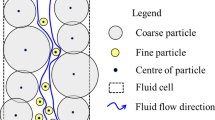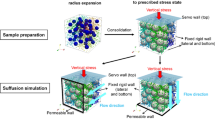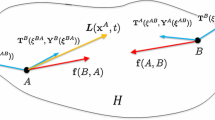Abstract
The behavior of lunar dust on the Moon surface is quite complicated compared to that on the Earth surface due to the small lunar gravity and the significant influence of the complicated electrostatic filed in the Universe. Understanding such behavior is critical for the exploration of the Moon. This work develops a smoothed particle hydrodynamics (SPH) model with the elastic–perfectly plastic constitutive equation and Drucker–Prager yield criterion to simulate the electrostatic transporting of multiple charged lunar dust particles. The initial electric field is generated based on the particle-in-cell method and then is superposed with the additional electric field from the charged dust particles to obtain the resultant electric field in the following process. Simulations of cohesive soil’s natural failure and electrostatic transport of charged soil under the given electric force and gravity were carried out using the SPH model. Results obtained in this paper show that the negatively charged dust particles levitate and transport to the shadow area with a higher potential from the light area with a lower potential. The motion of soil particles finally comes to a stable state. The numerical result for final distribution of soil particles and potential profile above planar surface by the SPH method matches well with the experimental result, and the SPH solution looks sound in the maximum levitation height prediction of lunar dust under an uniform electric field compared to theoretical solution, which prove that SPH is a reliable method in describing the behavior of soil particles under a complicated electric field and small gravity field with the consideration of interactions among soil particles.











Similar content being viewed by others
References
Afshar-Mohajer N, Wu CY, Curtis JS, Gaier JR (2015) Review of dust transport and mitigation technologies in lunar and Martian atmospheres. Adv Space Res 56(6):1222–1241
Afshar-Mohajer N, Wu CY, Moore R, Sorloaica-Hickman N (2014) Design of an electrostatic lunar dust repeller for mitigating dust deposition and evaluation of its removal efficiency. J Aerosol Sci 69:21–31
Afshar-Mohajer N, Wu CY, Damit B, Sorloaica-Hickman N (2011) In: 41st international conference on environmental systems Portland, Oregon
Aplin KL, MacFaden AJ, Bowles NE (2014) Modelling of an asteroid photoelectron sheath and implications for a sample return mission. Planet Space Sci 99:103–111
Berg OE, Richardson FF, Burton H (1973) Lunar ejecta and meteorites experiment. Apollo 17: Preliminary science report. NASA SP-330, Published by NASA, Washington, D.C., 1973, p 16, 330, 16
Birdsall CK (1991) Particle-in-cell charged-particle simulations, plus Monte Carlo collisions with neutral atoms, PIC-MCC. IEEE Trans Plasma Sci 19(2):65–85
Walch B, Horanyi M, Robertson S (1995) Charging of dust grains in plasma with energetic electrons. Phys Rev Lett 75(5):838–842
Bui HH, Fukagawa R, Sako K, Ohno S (2008) Lagrangian meshfree particles method (SPH) for large deformation and failure flows of geomaterial using elastic–plastic soil constitutive model. Int J Numer Anal Methods Geomech 32(12):1537–1570
Chen W-F, Mizuno E (1990) Nonlinear analysis in soil mechanics?: theory and implementation. Elsevier, Amsterdam
Fulk DA (1994) A numerical analysis of smoothed particle hydrodynamics. Ph.D. Thesis Air Force Inst. of Tech., Wright-Patterson AFB, OH
Gingold RA, Monaghan JJ (1977) Smoothed particle hydrodynamics: theory and application to non-spherical stars. Mon Not R Astron Soc 181(3):375–389
Han D, Wang P, He X, Lin T, Wang J (2016) A 3D immersed finite element method with non-homogeneous interface flux jump for applications in particle-in-cell simulations of plasma-lunar surface interactions. J Comput Phys 321:965–980
He C (2010) Geotechnical characterization of lunar regolith simulants. Doctoral dissertation. Case Western Reserve University, OH, USA
Hughes ALH, Colwell JE, DeWolfe AW (2008) Electrostatic dust transport on Eros: 3-D simulations of pond formation. Icarus 195(2):630–648
Kawamoto H, Uchiyama M, Cooper BL, McKay DS (2011) Mitigation of lunar dust on solar panels and optical elements utilizing electrostatic traveling-wave. J Electrost 69(4):370–379
Libersky LD, Petschek AG, Carney TC, Hipp JR, Allahdadi FA (1993) High strain Lagrangian hydrodynamics. J Comput Phys 109(1):67–75
Liu GR, Liu MB (2003) Smoothed particle hydrodynamics: a meshfree particle method. World Scientific, Singapore
Liu G, Marshall JS, Li SQ, Yao Q (2010) Discrete-element method for particle capture by a body in an electrostatic field. Int J Numer Methods Eng 84:1589–1612
Liu MB, Liu GR (2010) Smoothed particle hydrodynamics (SPH): an overview and recent developments. Arch Comput Methods Eng 17(1):25–76
Liu MB, Liu GR, Zong Z (2008) An overview on smoothed particle hydrodynamics. Int J Comput Methods 5(1):135–188
Lucy LB (1977) A numerical approach to the testing of the fission hypothesis. Astron J 82:1013
Mao Z, Di B, Zhang J (2013) Theoretical simulation of electrostatic levitation of lunar dust. Appl Math Mech 34(4):336–344
Mao Z, Liu GR, Dong X (2017) A comprehensive study on the parameters setting in smoothed particle hydrodynamics (SPH) method applied to hydrodynamics problems. Comput Geotech 92:77–95
Mao Z, Liu GR (2018) A Lagrangian gradient smoothing method for solid-flow problems using simplicial mesh. Int J Numer Methods Eng 113:858–890
Monaghan JJ (1985) Artificial viscosity for particle methods J.J. Monaghan and H. Pongracic. Appl Numer Math 1:187–194
Monaghan JJ (1992) Smoothed particle hydrodynamics. Ann Rev Astron Astrophys 30(1):543–574
Monaghan JJ (1994) Simulating free surface flows with SPH. J Comput Phys 110(2):399–406
Morris JP, Fox PJ, Zhu Y (1997) Modeling low reynolds number incompressible flows using SPH. J Comput Phys 136:214–226
Pines V, Zlatkowski M, Chait A (2011) Lofted charged dust distribution above the Moon surface. Planet Space Sci 59(14):1795–1803
Poppe AR, Piquette M, Likhanskii A, Horányi M (2012) The effect of surface topography on the lunar photoelectron sheath and electrostatic dust transport. Icarus 221(1):135–146
Randles PW, Libersky LD (1996) Smoothed particle hydrodynamics: some recent improvements and applications. Comput Methods Appl Mech Eng 139(1–4):375–408
Rennilson JJ, Criswell DR (1974) Surveyor observations of lunar horizon-glow. Moon 10(2):121–142
Robertson S, Gulbis AAS, Colwell J, Horányi M (2003) Dust grain charging and levitation in a weakly collisional sheath. Physics of Plasmas 10(10):3874–3880
Sickafoose AA, Colwell JE, Horányi M, Robertson S (2002) Experimental levitation of dust grains in a plasma sheath. J Geophys Res Space Phys 107(A11):1408
Sickafoose AA, Colwell JE, Horányi M, Robertson S (2000) Photoelectric charging of dust particles in vacuum. Phys Rev Lett 84(26):6034–6037
Singer SF, Walker EH (1962) Electrostatic dust transport on the lunar surface. Icarus 1(1–6):112–120
Stubbs TJ, Vondrak RR, Farrell WM (2006) A dynamic fountain model for lunar dust. Adv Space Res 37(1):59–66
Swegle JW, Hicks DL, Attaway SW (1995) Smoothed particle hydrodynamics stability analysis. J Comput Phys 116(1):123–134
Wang X, Horányi M, Robertson S (2009) Experiments on dust transport in plasma to investigate the origin of the lunar horizon glow. J Geophys Res Space Phys 114(5):2–7
Wang X, Horányi M, Robertson S (2011) Dust transport near electron beam impact and shadow boundaries. Planet Space Sci 59(14):1791–1794
Author information
Authors and Affiliations
Corresponding author
Ethics declarations
Conflict of interest
The authors declare that they have no conflict of interest.
Rights and permissions
About this article
Cite this article
Mao, Z., Liu, G.R. A smoothed particle hydrodynamics model for electrostatic transport of charged lunar dust on the moon surface. Comp. Part. Mech. 5, 539–551 (2018). https://doi.org/10.1007/s40571-018-0189-4
Received:
Revised:
Accepted:
Published:
Issue Date:
DOI: https://doi.org/10.1007/s40571-018-0189-4




